These days, Facebook Ads are a must-have for every business. Thanks to Facebook’s unnervingly accurate targeting tools, Facebook Ads are the easiest way to reach your target audience online.
Don’t just take our word for it, though. Facebook is the most used social platform for marketers and 81% of businesses prefer to use Facebook for their marketing efforts.
If you’re yet to jump aboard the Facebook advertising bandwagon, this all-in-one guide is here to help. We’ve compiled everything you need to know about Facebook Ads into a single article to help you become an expert quickly.
If you’re fresh-faced to Facebook Ads, start here at the top of the page. If you’ve been around long enough to remember life before ad sets and carousels, skip ahead to the topics you want to hone.
Why run ads on Facebook?
There’s a lot to love about advertising on Facebook, but the biggest benefits boil down to:
The (really) huge audience. The social giant boasts a whopping 2.74 billion active monthly users, 1.82 billion of them signing in every day.
Ridiculously specific targeting. Facebook’s audience targeting abilities are unparalleled. Show your ads to everyone or just the select few who really count.
- You’re in the driver’s seat. Facebook Ads Manager gives you control of Facebook’s most powerful advertising and targeting tools. It’s exactly the same tool as the pros use.
As marketing has become more and more personal, so has the importance of finding the right audience. Without this, a campaign’s chance of success is limited. You’ll simply be talking to the wrong people.
Facebook not only gives you access to the right audience, but it also gives you the power to customize and optimize targeting however you’d like. That’s a whole lot of power if you know what to do with it (and if you don’t, just keep on reading).
Connecting with your target audience on Facebook
If know a little about marketing, you probably already know who your target persona is. You might have one, two, or ten separate types of people that you want to market to.
Facebook lets you bring those marketing personas to life. Or, more accurately, it finds the real-life carbon copies of your marketing personas and puts your ads in front of them. Simply tell Ads Manager who they are — where they live, what their interests are, how they behave online — and Facebook will serve them your ads.
We’ll get more into how to do that below, but for now, it’s just important to understand that audience targeting is what makes Facebook special.
Video ads perform better than images or text
Facebook is really good at ads. No matter what kind of ad it’s handed, it’ll make sure the people who are most likely to engage with it see it. But it’s just a cold hard truth that some ads are more engaging than others.
Facebook, like most social platforms, is becoming more and more video-oriented by the day. In fact, a Facebook executive predicted the platform would be all video by 2021 — that’s how convinced they are that video is the next big thing. Video gets 1200% more shares than text and image content combined, and Facebook loves things that drive engagement.
Based on our own experiment, we also found that video outperforms images in Facebook Ads based on click-through rate and ROI. Read our video vs. image Facebook Ad experiment to see the results for yourself.
To help you easily prepare video creative for your Facebook Ads, we have a big selection of pre-made templates ready for you to edit. Choose from a big range of styles and industries in our Facebook Ads template library.
Facebook Business Manager: The doorway to Facebook Ads
If you want to make Facebook Ads, the place to start is Facebook Business Manager. Think of Business Manager as your control room. It lets you monitor Facebook ads comments and manage everything from one place. It’s also the place you access Facebook Ads Manager.

The tools you’ll find in Facebook Business Manager
Facebook promotes Business Manager as a more secure way to manage your pages and ad accounts. It isn’t just about ads — it’s truly a one-stop-shop for everything your business needs on Facebook. Within Business Manager, you have access to:
Ads Manager. Create and control everything ad-related on Facebook.
Ads Reporting. Breakdown and analyze the results of your ads with Facebook’s handy dandy reporting tool.
Analytics and Audience Insights. Understand who your audience is and what they’re doing on your page.
Business Settings and Billing. Assign roles and permissions, monitor linked pages and accounts, and control payment and billing information.
Catalog and Commerce Managers. Manage any products you promote on Facebook with Shops.
Collaboration Center. Work with partners and other brands right within Facebook’s Business Manager. Launch the next great collaboration campaign.
Events Manager. Track Facebook Pixel event data in Events Manager. See when your Facebook Ad leads to a sale or specific action on your website. (More about Pixel later).
- And a whole lot more. From Media Libraries to Brand Safety, Business Manager gives you access to all the tools your business might need on Facebook.
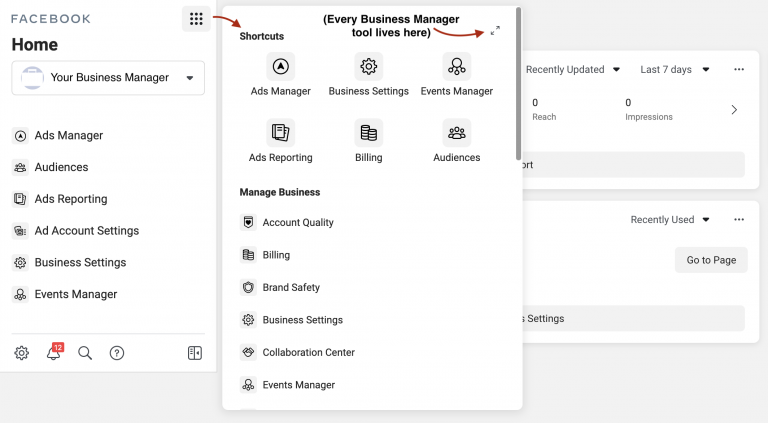
How to create a Business Manager account
To run Facebook Ads you’ll first have to create a Business Manager account and a business profile at business.facebook.com. That might sound complicated, but it’s as simple as typing in a few business details (like the name of your business and your business email). From there, you’ll be ready to explore the Business Manager dashboard.
Of all the tools Business Manager offers, one of its greatest gifts is a more manageable work/life online balance. Business Manager lets you keep your business page separate from your personal profile, so you don’t have to think about work every time you open Facebook on the weekends. Automated ad reports are pretty great, but we’d argue happy employees are even better.
Facebook Ads Manager: The place to control your ads
If Business Manager is the control room, Ads Manager is the control board with the flashiest light-up buttons and fanciest switches. Things get real in Ads Manager.
Ads Manager is a part of Business Manager, and as we mentioned above, you can access it from your Business Manager dashboard.
Like any control board with light-up buttons and rows and rows of switches, Ads Manager can look intimidating if you don’t know what you’re looking at. It’s important to remember that while Ads Manager is a powerful tool, not all of the buttons will be applicable for what you need. Let’s walk through the basics.
How to create a Facebook Ads account
If it’s your first time using Facebook Ads, you’ll need to start by creating an Ads account in the “business settings” section of Business Manager. Facebook will ask you to add people and set permissions for who can control what on your ads account — you can pick between standard access or admin access for each person. Admins are the only users able to manage finances and permissions.
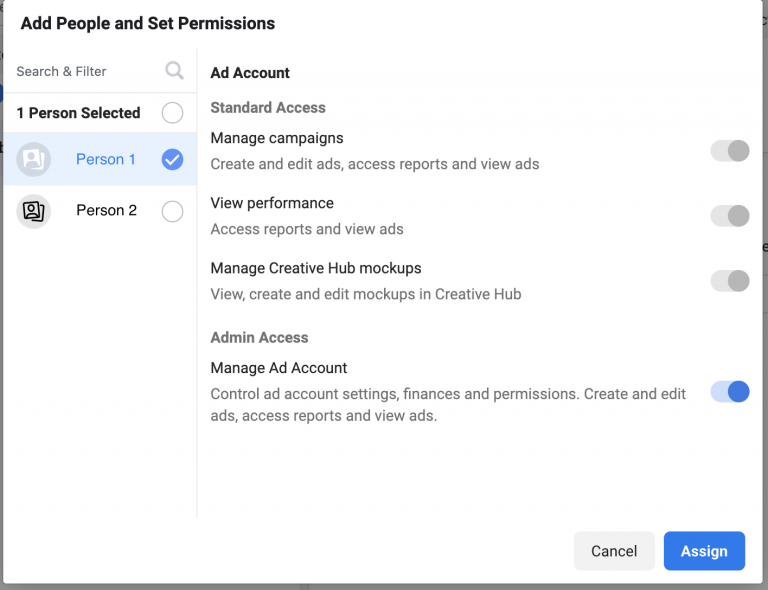
Before you can use the account, you will also need to add a payment method. Facebook won’t charge your account until you’re ready to launch an ad campaign, have set your budget, and confirmed the purchase of your ad.
In the Ads Manager dashboard you’ll see an overview of active campaigns in one tab, and a breakdown of all your campaigns, ad sets, and ads in the other.
What you can do in Ads Manager
Before we take you through the nitty-gritty of Ads Manager, let’s quickly cover the parts that are combined in every Facebook Ad: campaigns, ad sets, and ads. Each part fits within the part listed before it, like Russian dolls.

Campaigns. Facebook Ad campaigns are at the top of the hierarchy and house all the other parts of your ad. This is where you’ll pick your campaign objective, which determines what success will look like for that campaign. If you have multiple objectives, you’ll need multiple campaigns.
Ad sets. Ad sets (and ads) are subsets of your campaign. This is where you’ll be creating and managing your target audience, ad budget, and ad placements. Most campaigns will have multiple ad sets within them so that you can create and test very specific audiences for your ad.
- Ads. Ads live inside ad sets at the bottom of the hierarchy. This is where you’ll select your ad format, creative, and text. If you’re using a Facebook Pixel to track the success of your ad, you’ll set it up here.
Understanding campaigns and ad objectives
Once you’re ready to begin your ad creation journey, select “create” on a new campaign. The first decision you’ll have to make is the objective of your campaign.
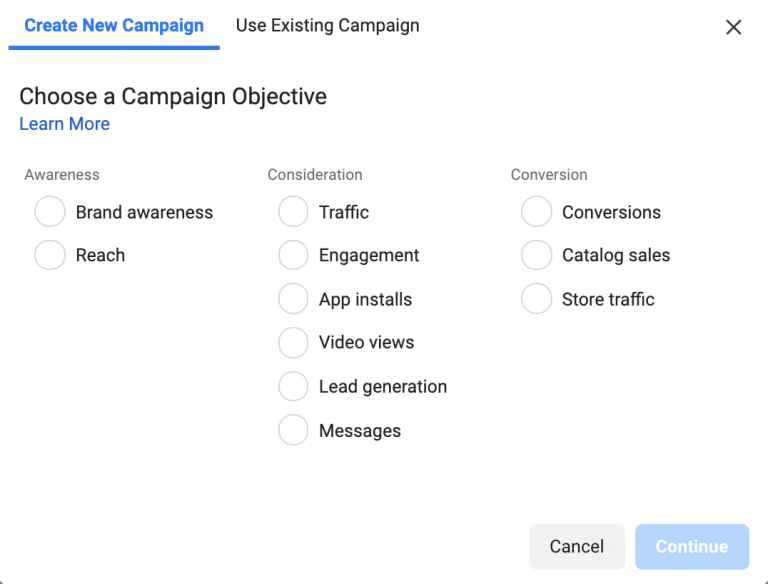
As we noted above, you’ll need a new campaign for each objective. If you’re looking for a complete funnel, you’ll need at least three campaigns on the go at once.
How to choose the right objective
There are objectives for each stage of the marketing funnel: awareness (to find new customers), consideration (to build relationships), and conversion (to make sales). It is crucial that you select the objective that best corresponds to the stage of the funnel you’re working in.
Some objectives can be used across the funnel (like video views), whereas others (like brand awareness) do their one job, and they do it well.
Awareness campaign objectives
- Brand awareness. Facebook puts your ad in front of the people most likely to remember it.
- Reach. Facebook aims your ad at as many people as it can. Reach typically isn’t the most useful objective for most campaigns.
Consideration campaign objectives
- Lead generations. If your goal is to collect new leads, this objective shows your ad to people who are most likely to convert.
- Traffic. Traffic finds people who like to click on things and be sent to another destination (like your website).
- Video views. Get your video ad seen by people likely to watch it. This one can also work magic at the awareness stage. ****
- App installs. Facebook shows your ad to people most likely to download your app.
- Messages. Encourages the social butterflies among us to engage with your business via Messenger.
- Engagement. Facebook finds the people most likely to like, react, comment, and share your ad. Engagement can be handy for raising awareness, too.
Conversion campaign objectives
- Conversions. Facebook aims your ad at people most likely to take valuable actions (like buy what you’re selling).
- Store traffic. If you want people to visit a physical store, this objective shows your ad to people most likely to stop by a location near them.
- Catalog sales. Facebook finds people interested in what you’re selling in your e-catalog.
The importance of picking the right objective
Choosing the right objective for your campaign is relatively simple, but choosing the wrong one can have big ramifications. We conducted an experiment on how much more choosing the wrong objective could cost you, and the answer was a wounding 4,238% more.
To help you avoid the mistakes we highlight in this experiment, we’ve created the following cheat sheet of which objectives are right for which for video ads.
Video objective cheat sheet
For video advertising specifically (it’s our forte), we recommend:
- Awareness campaigns: Select Video Views or Post Engagements
- Consideration campaigns: Select Traffic or Leads
- Conversion campaigns: Select Conversion
Take the time to carefully think about what you want your ad to achieve and which objective will be best to accomplish that. We can’t emphasize this enough: it really will make or break your whole campaign.
Find your audience with Facebook Ad targeting
Facebook’s powerful targeting capabilities let you harness the Facebook algorithm to target as broadly or as precisely as you’d like. Facebook will automatically show your ad to the people it knows will find your ad relevant. The more you give Ads Manager to work with, the more it will give you back in return.
When creating an ad in Ads Manager, Facebook offers three different audience selection tools:
Core audiences. Find your audience based on age, geography, and interests you select from a very, very comprehensive database.
Custom audiences. Retarget website visitors or existing customers by providing Facebook with custom data, like email addresses. Facebook will match your data to its users and find them on Facebook.
- Lookalike audiences. Reach new people with interests similar to your existing customers.
Core audiences is the most “basic” audience selection and targeting tool of the bunch. Not because it isn’t unbelievably comprehensive and effective, but because it’s the most standard and most broad of all the options.
How to set up your core audience
Core audiences let you target based on what your audience had for breakfast or the color of their kitchen sink. Well, almost. This is how to set up yours.
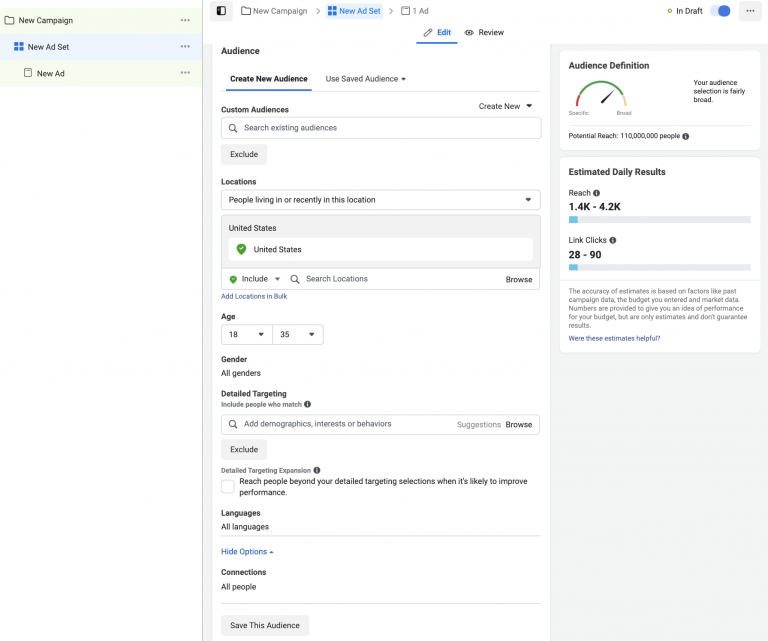
1. Location
First up is location. Choose which postcodes, cities, or countries you want your ad to be seen in.
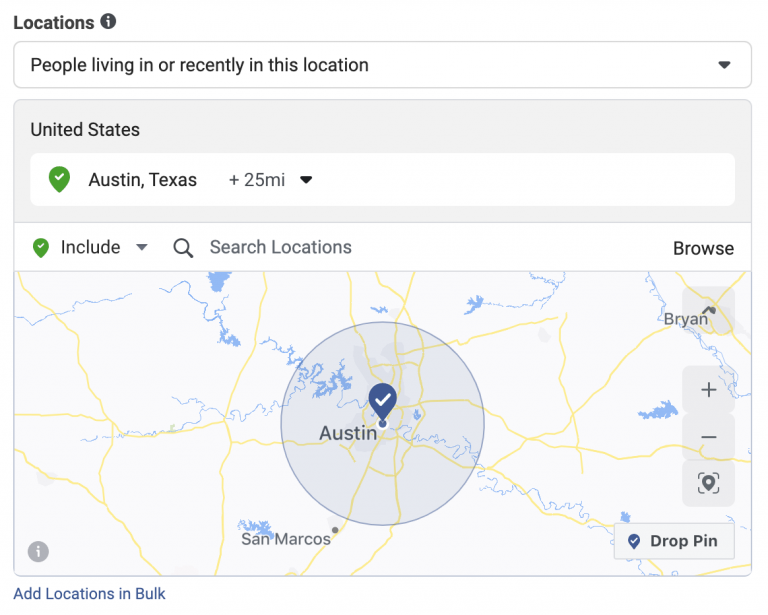
Let Facebook know whether to show your ad to everyone in your selected location, people who live there, anyone who was recently in the location, or just tourists traveling through.

2. Demographics
Narrow down who your target audience is by dialing in their demographic. This includes age, gender, marital status, education, income, job title, political views, etc. Facebook knows all.

3. Interests
Filter your audience by their interests and hobbies to show your ad to people who will find it most relevant. This can really be anything — action figurines, rowboats, competitive bowling, vegan food — whatever it is, Facebook probably has users who are into it. For example, if you’re selling dog food, you’d want to tell Facebook to look for people who have liked dog pages, pet store pages, or dog groomer pages.
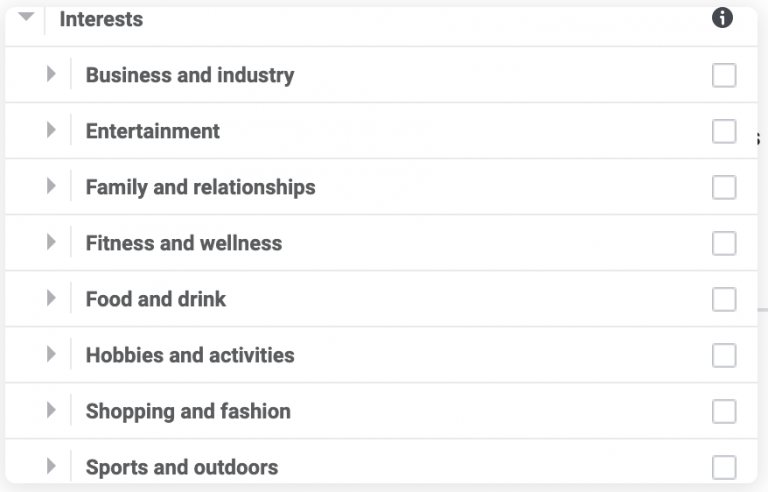
4. Behaviors
Target users based on the behaviors Facebook can track, such as users who have an anniversary within 90 days or what they’ve recently purchased. Behavior really delivers the goods when used with a Facebook Pixel to track specific events, like people who recently visited your website without buying anything.

5. Connections
Choose whether to include people who already like your page or are friends of people who do. If you’re looking for a new audience, exclude your old one. Connections also let you filter in or out people who have downloaded your app or responded to an event.

Use any and all of the targeting tools outlined above to target your audience. You can create audiences from the “Audiences” tab in Business Manager, or in the Ad Sets stage of ad creation in Ads Manager.
Set your relevant targeting selections, then be sure to hit “Save This Audience” to quickly access your audience preferences in the future.
If you’re not able to find your exact audience straight away, persevere. Small niches can be hard to target, but if you’re creative about your choices, you’ll always find them.
A useful insight when creating audiences is knowing who’s already interacting with your business on Facebook.
Audience Insights: Understand who to target
Audience Insights offers a look behind the curtain at who already connects with your page and provides invaluable data on Facebook users as a whole. This will come in handy when you’re trying to define your target market.
Use Audience Insights to reveal where your audience lives, how old they are, what their job is, what they do for fun, what other pages they’ve liked.
You’ll find Audience Insights within Business Manager. From here you can either choose to explore the insights for people connected to your page, all people on Facebook, or any custom audiences you’ve made.

How to use Audience Insights to find yours
To find out more about the people who already like your page, select the “people connected to your page” filter. If you’re more interested in grabbing relevant data outside your current audience, try starting with “people on Facebook” and filtering from there.
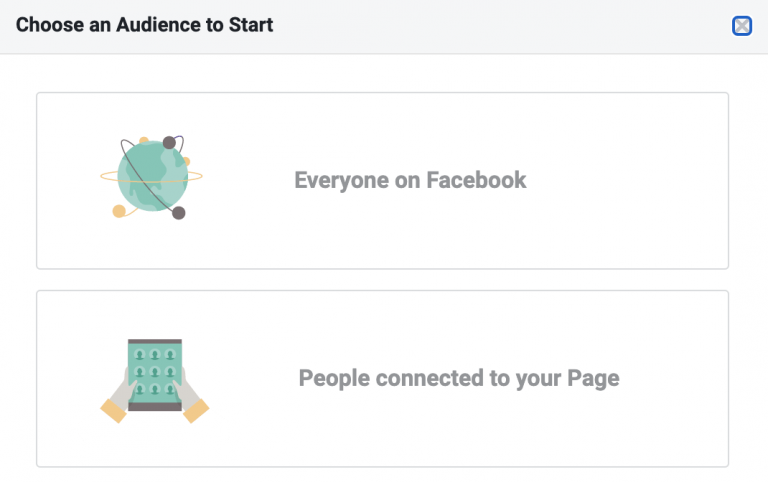
Start by entering in what you know definitely applies to your target audience. For example, if your business is only based in Austin, Texas, filter your demographic to match. This will give you the current data for all Facebook users in Austin, like their gender, marital status, and interests.
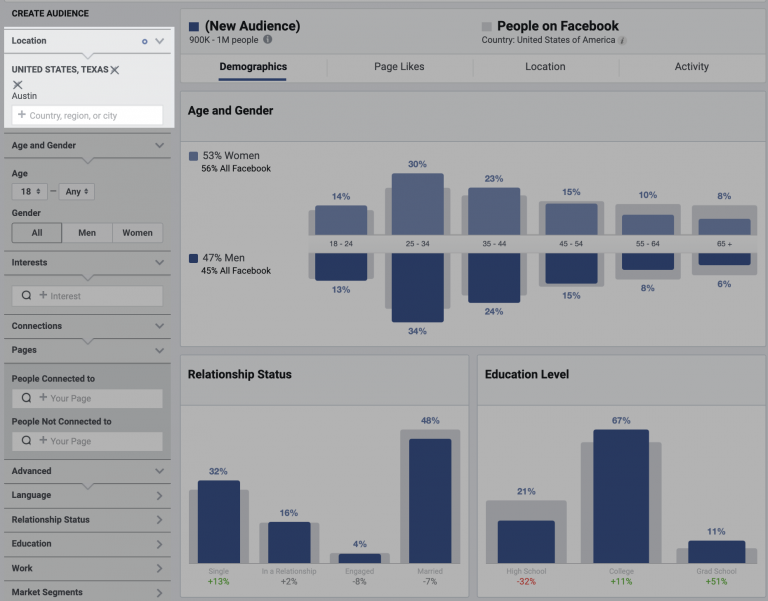
From here, narrow down the audience via interests that relate to your business. Let’s say you run a cat cafe in Austin. Filter the interests down to “cats” and “coffee shops” to find people who might be likely to stop by your thriving cat cafe.
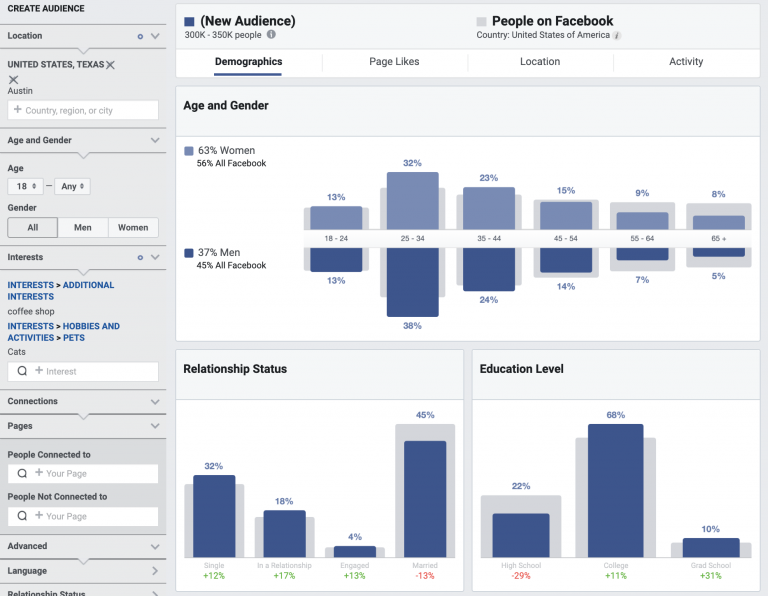
Now you know 63% of your target audience are women, most commonly in the 25-44 age range.
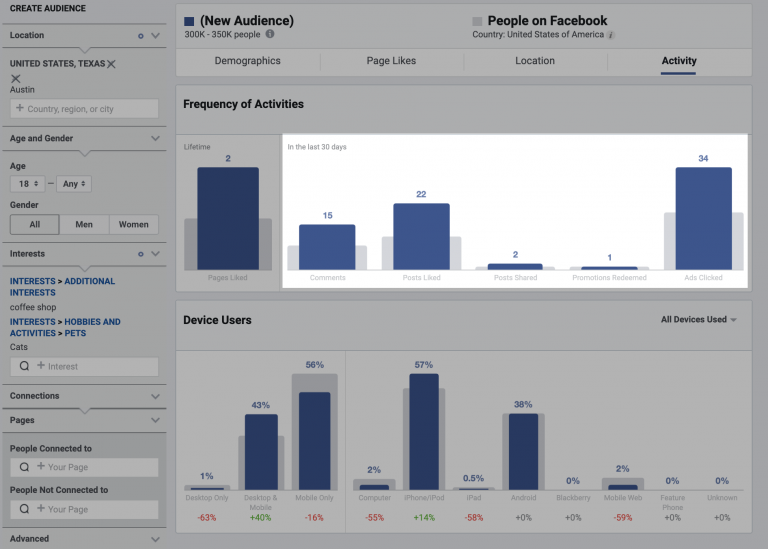
The data also shows that this target audience is almost twice as likely to interact with posts and click on an ad than the average Facebook user. That’s all useful, juicy data that you can use to better target future ads and make your budget really count.
Custom Audiences: Curating who sees your ads
Custom Audiences are a highly valuable and effective audience selection tool. Because, well, they’re custom to your business. Custom Audiences allow you to do fancy things with your Facebook marketing, like retarget users who almost made a purchase on your store.
Because you know your custom audience has an existing relationship with your brand, you know that they’re more likely to engage or convert again.
Facebook offers a variety of options for creating and curating your custom audience, with varying degrees of data required from you to achieve them.
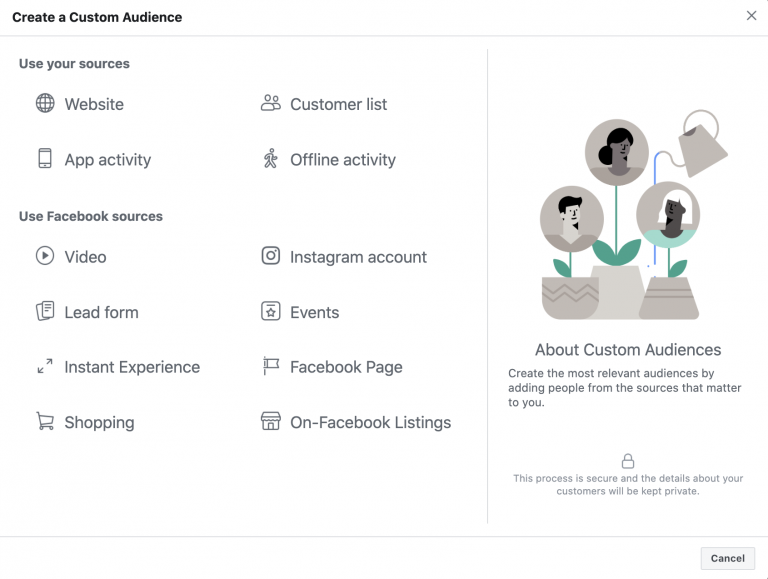
Website. Create an audience based entirely on visitors and actions taken on your website. Customizing your audience via website traffic requires a Facebook Pixel, which lets Facebook follow customers from your website back to Facebook. (Stay tuned for more on Pixels, how to set them up, and what they’re all about).
Customer list. Import your own customer/mailing lists in a CSV or TXT file straight to Facebook. Facebook will match the provided identifier (email, phone number, etc.) to the user’s Facebook account and include them in your custom ad audience. If you use Mailchimp, you’re in luck: Facebook lets you import data directly from Mailchimp within the Ads platform to keep things as easy as can be.
App activity. This one is, obviously, only relevant if you’ve got an app to work with. If you do, you can create an audience of people who interacted with your app, or made a specific action within it, such as a purchase.
Offline activity. Bring the offline online with an audience of people who visited your physical store or spoke with you over the phone. This one requires an “offline event set,” which you can create in the “Events Manager” tab of Business Manager. It’s a little finicky but can result in golden data for creating a lookalike audience.
- Facebook sources. Compile a list of people who have engaged with your Facebook account with the click of a button. Base your audiences off video viewers, online event responders, Facebook Page or Instagram account interactions, and more.
While some of these sources might seem daunting, adding them is relatively easy. Click “Create New Custom Audience” in the “Audiences” tab of Business Manager, or when creating your ad sets in Ads Manager, select your preferred source, then let Facebook walk you through the rest.
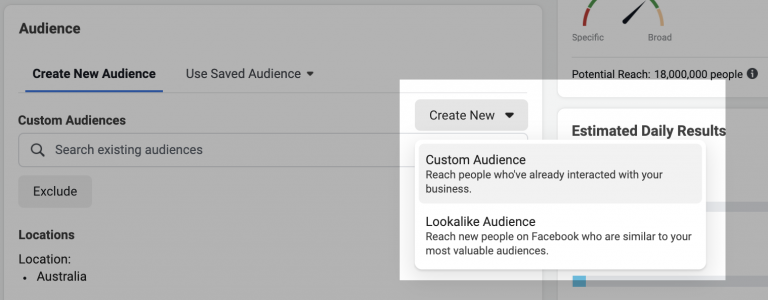
Lookalike Audiences: Finding people similar to an existing group
Lookalike Audiences let you reach the doppelgangers of a custom group you’ve created. For example, Facebook will take your customer list of existing consumers and find the people who behave just like them online (and, probably, in real life). Because lookalikes are essentially carbon copies of your customers, they’re far more likely to also convert than the standard Facebook user might be.
Creating a Lookalike Audience is relatively straightforward. Again you’ll find what you’re looking for in either the “Audiences” tab of Business Manager or in the Ad Sets section of Ads Manager.

Click on “Create a Lookalike Audience” and choose your lookalike source. This might be one of your custom audiences or the users who already like your page. Then select which countries you want Facebook to identify lookalike users in, and the percentage of that population’s lookalike users you want to show your ad to. A 1% lookalike looks the most similar to your source audience, and widening the audience size creates a larger, broader audience.
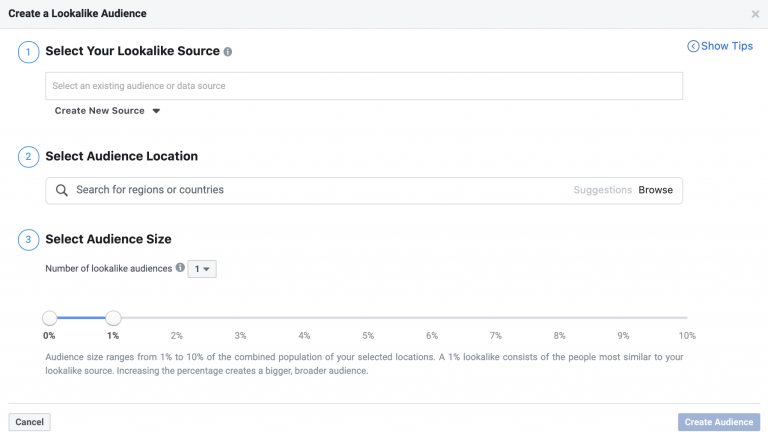
Setting up your Facebook Ads
If you’ve made it this far down the page, you’ve worked through the first two steps of the Ads Manager hierarchy, and you’re ready for the third: the ad itself.
There are four main types of Facebook Ads: image, video, carousel, and collection. Slideshow and video polls are both essentially video ads too, but with a little extra something sprinkled into the mix.
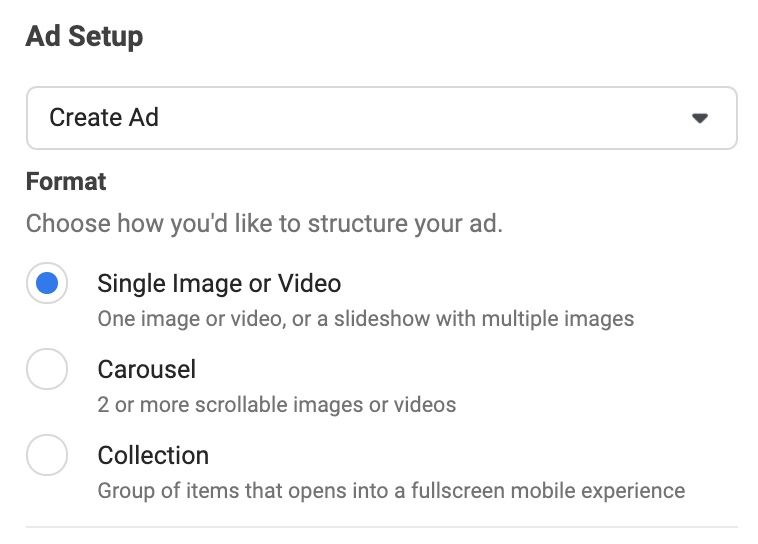
Single image ads
This one really speaks for itself. Single image ads consist of one image paired with your chosen ad creative and a call to action. Be sure to use high-quality images of at least 1280 x 720 pixels. There’s nothing wrong with this ad type, per se, but it’s usually pretty easy to scroll past.
Video ads
Video ads are almost always the way to go. Video ads feature a (typically) short and snappy video that engages the viewer and drives home your message.
Facebook accepts all the standard video formats and recommends optimizing aspect ratios for mobile, so 4:5 or 1:1. You’re not likely to run into Facebook’s 4GB file size limit, and if you do, it’s probably for the best to rethink the length of your cinematic masterpiece.
We recommend keeping ads shorter than 30 seconds, ideally around 15 seconds. The shorter an ad is, the greater the chance it will be watched to the end, and in turn, the less Facebook will charge you to run it.
Slideshow ads
Upload 3-10 images to create a slideshow ad right in Ads Manager. Because we all unanimously agree that video ads are better than image ads, Facebook will turn your images into a 15-second slideshow video with the press of a button. Edit the length of each image and add music if you’re feeling it.
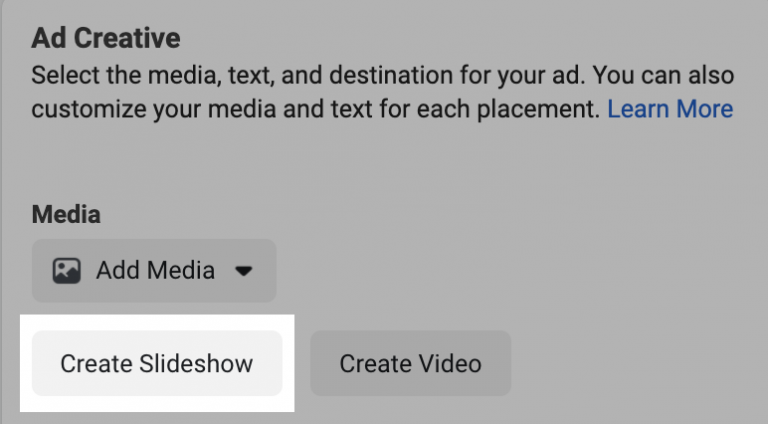
Video poll ads
These are video ads, but fancy. Encourage engagement by adding an interactive poll to your video ad. Simply upload your video in Ads Manager and click “add poll” to…add a poll. Edit the placement and text of the poll, then let it loose into the wild.
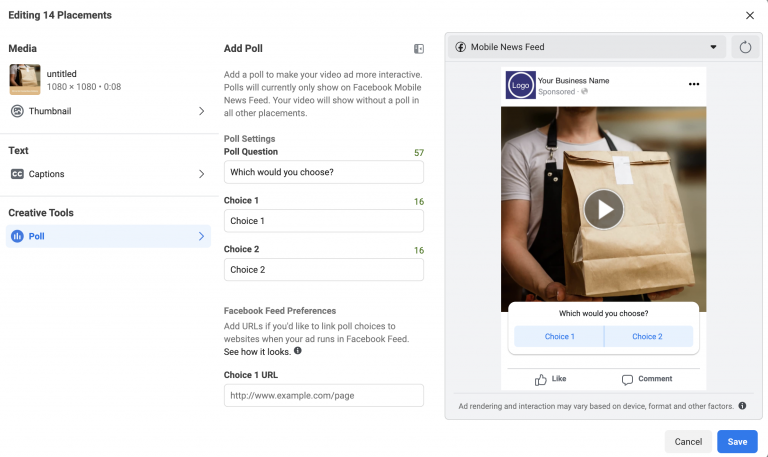
Carousel ads
Showcase up to 10 images or videos in the one ad, with up to 10 different links. Users can click through the carousel, a bit like a manual slideshow. The most significant benefit is the ability to send your audience directly to each product’s specific destination URL.

Collection ads
Also known as an Instant Experience, or previously a Canvas ad, collection ads are a group of items that open to a full-screen experience for mobile users. You’ll need to select “choose a template” to create an Instant Experience using one of Facebook’s offered templates or create your own from scratch. From there, Facebook will launch a screen where you can design your Instant Experience utilizing a combination of ad styles (like carousels, videos, images, text, and links).
This is an advanced ad type undertaking and only works on mobile, but when it works, it really works.
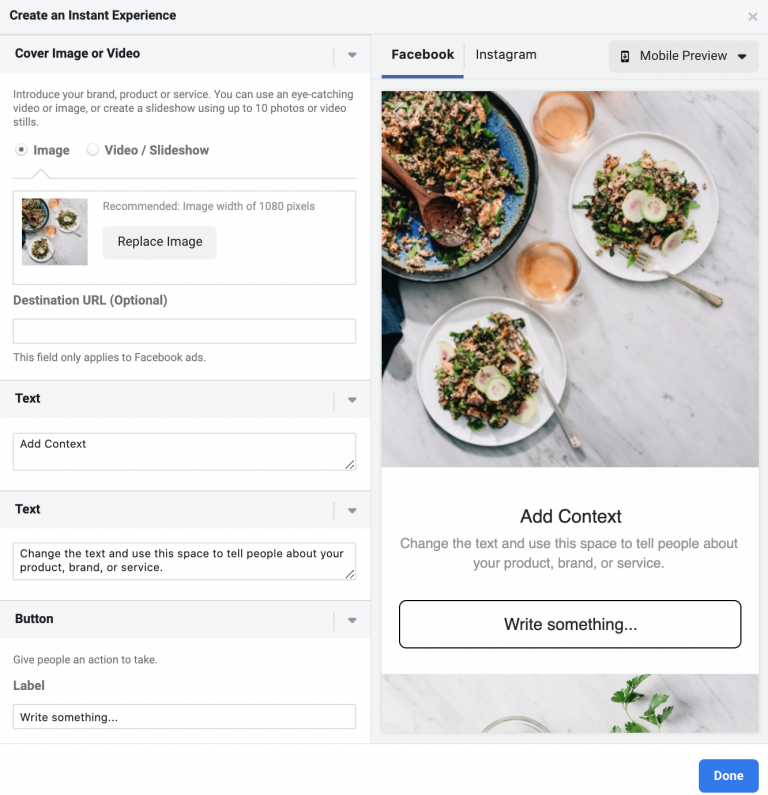
Facebook Ad guidelines: Things Facebook won’t let you do
Because Facebook wants you to succeed, they’ve established a set of guidelines and requirements to make your ads the best ads they can be. For the most part, Facebook will just let you do your thing, but there are some ad specs and prohibited content you need to be aware of.
Restricted and prohibited content
There are some things that just won’t fly on Facebook. Facebook clearly outlines its restricted and prohibited content so you won’t be caught off guard. Most of it is common sense and isn’t likely to cause you any problems. But if you do find yourself with an ad Facebook won’t approve, it might be for one of the following reasons.
- Profanity
- Adult content (nudity, etc)
- Hate speech and harassment
- Tobacco or drug sales (prescription or otherwise)
- Illegal products or services
- Discrimination or discriminatory practices
- Third-party infringement
- Misinformation or controversial content
Facebook’s ad approval process
Before your ad can appear on Facebook, it will undergo a review and approval process to ensure it meets Facebook’s standards and community guidelines. This usually takes place within 24 hours, and if any problems are found, you can edit your ad to fix them up.
If you find your ad content has been incorrectly flagged for one of the restrictions above, you can dispute the decision in the “Account Quality” section of Business Manager.
Image ad specs and guidelines
Limit text in your images
Until recently, Facebook had strict restrictions in place for the amount of text allowed in image-based ads. The Facebook Ad gods wouldn’t approve anything with more than 20% text. The text in images restriction is no more, but Facebook still stands by their long-held belief that images with less than 20% text perform better, so it’s always something to keep in mind.
Keep spirits and resolutions high
No one likes a pixelated image. Use high-resolution images for your ads wherever you can. Your ad will be easier to view, and your brand will be putting its best foot forward. For images shown in the news feed, anything less than 479 x 246 pixels won’t meet Facebook’s minimum requirements, and your ad won’t be approved.
Shape-shift your image for each placement
Depending on which ad placements you choose, the ideal aspect ratio for your image will differ. Facebook recommends:
- Square 1:1 images for feed placements and carousel formats.
- Vertical 9:16 images for Facebook Stories placements.
Video ads specs and best practices
Facebook doesn’t have too many guidelines on what makes a good video ad, but we sure do.
Keep things short and sweet
The best Facebook video ads sit somewhere between 5 and 30 seconds. We’d say aim for no longer than a 15-second video in most cases. Shorter ads drive higher engagement rates, so don’t get waffly.
Include a call to action in your video
Don’t miss the chance to prompt your audience with a relevant call to action right in the video. You’ll most commonly place it at the end of your video to tell viewers what to do next, like “Shop now”.
Show off your logo
Whether you whack it at the start or end of your video, make sure your logo is in there somewhere. For awareness and consideration content, show it from the start as a watermark. This will help grow your brand awareness, regardless of video view length. For conversion content, be sure to show it at the end of your video so the user knows where they’ll be going next.
Captions count
Since 85% of Facebook videos are watched without sound, captions are always a good idea. Ideally, avoid a voiceover and just show your message on-screen as animated text.
Keep your thumbnails text-free
Avoid text in your thumbnail where you can. Facebook recommends keeping it at under 20% text for better engagement with your video ad.
Use appropriate aspect ratios
Always make your videos (images) the right shape for their intended placement.
- Mobile 4:5 video for feed placements (we think square 1:1 works well in a pinch, as well).
- Square 1:1 video for the carousel formats.
- Vertical 9:16 video for Facebook Stories placements.
- Horizontal 16:9 video for in-stream video placements.
Boosting posts explained
Alongside Ads Manager controlled posts, Facebook also offers the option to “boost” posts on your page. This involves taking an existing post on your page, putting some money behind it, and having Facebook show it to more people.
Sounds good, right? Yes and no. Boost is quick and easy to use, but it won’t give the same level of control or results that Ads Manager will.
To boost or not to boost
To gain an understanding of how much better Facebook Ads perform than boosted posts, we put some money down and ran an experiment. What did we find? Ads Manager beat Boost hands down.
Our Ads Manager controlled ad scored 230% more clicks and twice as many views and completed views. Read our experiment write up to learn more.
Interestingly, Boost did come out ahead in finding people who were more likely to react and share your content. This is useful if you’re looking to accrue social proof on your post, such as likes and comments. For all other purposes, use Ads Manager to run your ads.
How to use Facebook Boost
If you do want to boost a post, you’ll find the “boost post” button right under each post on your page. Once you click it, Facebook will take you to a watered-down version of the Ads Manager process.

The boost interface will prompt you to select your goal. The default is “automatic” for boosted posts, which lets Facebook select the most relevant goal based on your settings. Your other options are:
- Get more website visitors
- Get more messages
- Get more engagement
- Get more leads
- Get more calls
- Get more video views (if the post you’re boosting is a video)

Next, you will need to select who should see your ad by narrowing down your audience. You still have access to Facebook’s full audience targeting tools, making this step much the same as in Ads Manager.
Finally, determine the duration and budget for your ad. Make sure Facebook has your payment details, and you’re all set to boost.
Facebook Pixel: The must-have tracking tool
Remember a few thousand words ago when we first mentioned the Facebook Pixel and how we’d circle back to it? Well, that time has come.
Facebook’s Pixel is a powerful little piece of code that tracks user behavior and sends whatever data it finds back to Facebook. Why the strange name? The Pixel is actually displayed as a single Pixel in every page within which it is embedded.
If the Pixel is correctly installed, it tracks your campaign’s success, helps create higher value audiences, and is the most integral player in your retargeting efforts.
What is the Facebook Pixel?
Facebook Pixel is your business’ individual secret audience builder. It’s what tracks that a user clicked on your website’s pricing page but didn’t sign up, and lets you give that user a nudge with a spookily specific targeted ad.
To get just a touch techy: a Pixel is a third-party Javascript (like a cookie) that collects information about the Facebook user visiting your site and sends that information back to Facebook. The Pixel is what connects actions taken on your website to a person’s Facebook profile: their demographics, their interests, and everything you need to know to use your Pixel to convert.
How to set up your Facebook Pixel
Getting your Pixel set up is a relatively painless process.
Start by heading to Business Manager and make your way to the “Events Manager” section from the dashboard. There you’ll find a big green ➕ button and the words “Connect Data Sources” — click it.
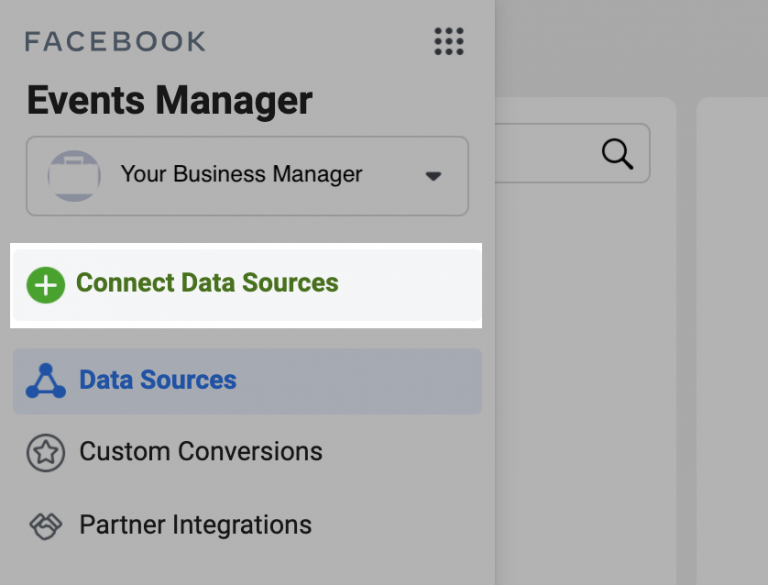
You’ll see three options: Web, App, and Offline. If you’re looking to install a Pixel in your website, “web” is where you’ll want to aim your mouse, then, finally, you’ll be asked to select a connection method — select “Facebook Pixel” then “connect.”
Give your Pixel a name and enter your website URL to check for easy setup options. If your website is hosted by one of Facebook’s integration partners (that’s WordPress, Squarespace, or Shopify), the interface will offer you an easier, integrated set up method. Facebook will walk you through the next steps in Events Manager.
Your other options are to manually add the Pixel code to your website or email the instructions to whoever is in charge of your website at your business.
To manually install your Pixel code, select “install code manually,” copy the Pixel base code, and paste it into your website’s CMS as instructed by Facebook.
That’s it. You’ve successfully installed a Facebook Pixel. The world of targeted Facebook marketing is officially your oyster.
If you’re not sure if you installed your Pixel correctly, download the Facebook Pixel Helper Chrome extension to double-check your work and sniff out any errors.
Why having Pixel installed is so handy
The two main reasons to use your Pixel are:
- To track the success of a conversion campaign from ad to checkout.
- To build campaigns and custom audiences based on your website traffic data.
“Events Manager” within Business Manager is where you’ll most likely spend time with your Pixel. As we touched on earlier, you’ll also find your Pixel becomes relevant whenever you’re on the hunt for a custom audience within Ad Sets. You’ll also see an option to add your Pixel as a method of tracking your ad at the final step of ad creation, right before you hit “publish” in the Ads Manager interface.
Retargeting: Taking a second shot at missed customers
Retargeting is remarketing. AKA marketing, again. Remarketing aims to reach the almost-customers your first attempts at marketing almost won over, and retarget them with different marketing methods.
Often these users are the most likely to convert. Think, an almost-customer who added an item to their cart before getting distracted and forgetting to checkout. You almost had the conversion, and you know the user was compelled to buy your product because your Pixel told you so.
Avenge their abandoned cart by putting your Pixel to use and retargeting with a custom audience ad. The Pixel and Facebook’s ad algorithm does most of the retargeting will do most of the heavy lifting, but you’ll still need to set up your Pixel and appropriate events, and tell Facebook what you want to do with all that data.
Video Creative: How to make video ads that perform
Now you know how to run Facebook Ads, the next step is to make your ad creatives. As we explained above, video is the way to go. Video outperforms images in most scenarios.
How to make a great video? Thankfully, Biteable makes that part quick and easy. Biteable is the world’s simplest video maker and the easiest way to make high-performing video ads.
Start with a ready-to-edit Facebook video template or a blank canvas and craft the perfect video in no time.



